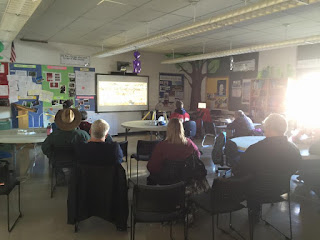My response to Montana's July 2017 ESSA plan, submitted to OPI 7/17/17
To Whom It May Concern:
Following is my feedback on Montana’s ESSA plan. I am responding
to the parts about which I have most knowledge, thereby leaving out feedback on
other aspects such as migrant students. I hope that you will take time to read
and consider it; I am happy to provide elaboration or clarification on anything.
Testing/Academic
Markers
Much of OPI’s plan is predicated on student test scores.
From identifying successful schools to schools in need of improvement, to pinpointing
the professional development teachers need – it mostly depends on a school’s
test scores according to this plan. I worry that this focus on testing will
renew teachers’ fears about the overtesting, testing preparation, and
overemphasis on scores that has plagued our schools since No Child Left Behind.
As for the 4% reduction, as a teacher in a Class C school that’s
also located on a reservation with large numbers in our “subgroups,” I am very
concerned about the rate of improvement the plan insists upon. Some of our students
face grave hardships in their lives, and our first and most important
responsibility as teachers is to support and guide them, especially when they
lack home support. Sometimes this means we have to place academics second. This
is not an excuse: it is reality. How will you gauge, with your percentage, the
success we teachers have with our students in their social-emotional
development? It simply feels that once again our students – and the efforts of
teachers – are being reduced to numbers.
On that note, I would strongly encourage considering alternates
to a standardized test such as the SBAC. Scored portfolios, writing
assessments, and math work can be incorporated into these goals. All this can
be quantified. Will it require training? Yes. Will the training itself lead to
better instruction? Very likely. So that’s a professional development
opportunity that doubles as a way to gauge student learning.
Targeted Schools
I am very concerned about the emphasis on remediation in
this plan. Schools are targeted for support when they, for example, fall in the
bottom 5% of the state’s rankings. They can exit this status only when they, in
part, rise above the 5% threshold. But rankings require that someone is in the bottom 5%. Does this
mean there will always be schools targeted for improvement, even if in the
hypothetical case that all schools meet the proficiency standards?
WIDA
There is a logical flaw in this plan’s approach to improvement
on the WIDA. The goal is for more students to reach 5.0 on the composite score,
but that’s also the exit score. This means that as soon as students reach the
goal, they are exited, leaving no students in the population with that high of
a score. Mathematically this means the population will never reach the goal
identified in this plan.
Title II Part A - This is a copy of the response I wrote to the previous ESSA plan. I have the same concerns today.
There are so many ways to innovate under ESSA in this arena of developing excellent teachers. Here is one specific idea: why doesn’t OPI write in some support for teacher leadership as a tangible part of district governance? OPI could use some of the state’s Title II money to develop an initiative supporting training of teacher leaders who might do what I did for one period a day last year (in my case, developing mentorship program and supporting accreditation efforts). District leadership could use exposure to this idea and the teacher leaders could use support. OPI could offer online webinars on the Learning Hub about teacher leadership for each subgroup.
Alternatively, Title II Part A allows the
creation of teacher and principal academies. Our schools’ leadership across the
state could benefit immensely from new ideas, a new culture of innovation and
progressive ideas. Yes, creating a principal academy would take a lot of
effort, but it would be so worth the effort. And the excellent principals and
superintendents who do good work in this state could be the frontrunners on the
effort. There are so many ways to innovate under ESSA in this arena of developing excellent teachers. Here is one specific idea: why doesn’t OPI write in some support for teacher leadership as a tangible part of district governance? OPI could use some of the state’s Title II money to develop an initiative supporting training of teacher leaders who might do what I did for one period a day last year (in my case, developing mentorship program and supporting accreditation efforts). District leadership could use exposure to this idea and the teacher leaders could use support. OPI could offer online webinars on the Learning Hub about teacher leadership for each subgroup.
Further, did OPI consider the teacher residencies? Our
teacher preparation programs need a lot of development, in my experience. OPI
could develop a partnership with one promising TPP in Montana to create and
pilot a real residency program in the spirit of helping pre-service teachers
dive into the experiences of teaching in meaningful ways that prepare them for
their own classrooms. We know that new teachers never feel fully prepared, but
we could do a lot better than siloed experiences of 30 or 45 hours followed by
a full semester of unpaid labor followed by all the responsibilities of an
actual classroom.
Specific to this plan,
on page 53, the plan reads, “The OPI will develop an annual plan to deliver
essential professional development across the state of Montana to educators in
schools that are identified for comprehensive, targeted, or universal support
in meeting student learning needs.” One way to read this is that OPI will
identify ongoing needs in specific districts and will help teachers meet them by
providing PD. Another way to read it is that if students do not make academic
progress based on test scores, it is the teachers’ fault and responsibility.
Perhaps there is a middle ground to be reached, where OPI
recognizes that changing classroom/teaching practices isn’t the only solution
to the myriad problems students in our schools face. Teachers can use support
in improving school culture (MBI meets this, so thank you for your continued support
of that), aiming for increased graduation rates through actual programming
supported by OPI, and connecting with communities and families in authentic ways.
Though outside the scope of a teacher’s traditional responsibilities, all of
this could assist teachers in reaching those kids and maybe addressing the test
scores that seem so important.
Equity
Yes, Montana has an equity plan, but it reads as a list of
existing efforts, not a comprehensive plan to coordinate and implement those
efforts. For example, how is the New Teacher Induction Project being leveraged
across CSPD/RESA and universities? Perhaps this collaboration exists, but it’s
not clear how. An equity plan has merit only if it’s an actual plan.
If OPI is looking for innovative approaches
to achieving equitable access to effective educators for all students may I recommend
this document published by the Aspen Institute and CCSSO. Some of OPI’s goals
reflect what’s here: http://www.ccsso.org/Documents/2016/ESSA/AdvancingEquityThroughESSA101316.pdf
It identifies 8 equity issues, provides ways to leverage ESSA to address those
challenges and includes “high impact state actions” for each. N.B.: Title II Part A can be used to support equitable access to excellent teachers.
Concerns/questions:
- Who is the stakeholder group that contributed to this plan?
- On page 35, the plan states, “By the fall of 2018, the OPI will determine the definition of an ineffective teacher.” How will this definition be developed? Who will be involved?
Anna E. Baldwin, Ed.D.
2014 Montana Teacher of the Year
Arlee High School English Teacher












